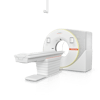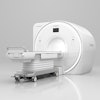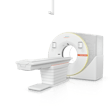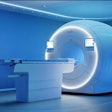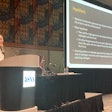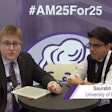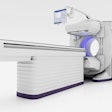
As part of a celebration of its 10-year anniversary, AuntMinnie is taking another look at notable articles that have run on the site over the past decade. This story describes new product introductions on the technical exhibit floor from the 1999 RSNA meeting.
CHICAGO - No one could ever accuse the medical imaging industry of complacency. From new technology introductions to corporate consolidation, radiology vendors have displayed an enormous appetite for change over the years.
This year has been no exception. Medical imaging companies have set a rapid pace on the consolidation trail, with many firms implementing mergers, acquisitions, or corporate makeovers as the year draws to a close. As a result, many attendees to the RSNA's technical exhibits this week will need a scorecard to keep track of the changes.
Some of the changes are more noticeable than others: Gone is Sterling Diagnostic Imaging, swallowed by Agfa in an acquisition in early 1999. In another major change, one of the oldest names in medical imaging, Picker International, will soon disappear as the Cleveland company takes on a new corporate identity as Marconi Medical Systems.
PACS vendors have been particularly peripatetic: ISG Technologies has changed its name to Cedara Software, while Access Radiology became eMed Technologies. Rogan Medical Systems of the U.S. is using the RSNA meeting to announce its switch to Imco Technologies.
Other changes are more subtle. Most of the deals in 1999 involved smaller firms rather than the blockbuster acquisitions that occurred in late 1998, when Kodak bought Imation, Philips acquired ATL, and Picker and GE swallowed up Elscint. More big deals could be in the offing, however, if radiology's active whisper network is to be believed.
Product highlights
Imaging vendors rarely churn out new technologies as efficiently as the rumor mill produces gossip, but this year's RSNA conference will still be a good one for new product introductions. In particular, the digital x-ray segment remains hot, judging by the number of new products introduced (although whether anyone is buying is a different story). The PACS market is taking a breather this year as hospitals await the outcome of the Y2K phenomenon, but some vendors are hoping for a flood of orders once the new year arrives.
The following listings offer a look at new product introductions at this week's meeting. Check back with us at www.auntminnie.com during the week to find out about late-breaking product announcements.
CT
The new multislice scanners introduced in 1998 appear to have met even the most optimistic expectations of CT vendors. The new scanners have revitalized CT sales, and are leading to new clinical applications, such as coronary artery scanning.
GE has shipped 200 LightSpeed QX/i scanners since introducing the multislice system last year. At this year's RSNA meeting, GE is showing as a work-in-progress CT perfusion software for stroke evaluation, as well as Direct 3-D, a 3-D imaging technique in which images are reconstructed during acquisition. The Waukesha, WI, vendor will add a new 0.7-second system to its CT product line, HiSpeed ZX/i, which will occupy a price point just below the company's high-end single-slice HiSpeed CT/i.
Philips Medical Systems North America has been one of the odd men out in the multislice race, but the Shelton, CT, company is taking steps toward improving its position with the introduction of the CT Vision line. CT Vision consists of two products, CT Aura and CT Secura, with Secura a 0.7-second scanner that is the platform for a future multislice offering. Philips estimates a multiarray system could be some 18 months away.
Siemens Medical Systems of Iselin, NJ, will show two new mid-range scanners, Somatom Balance and Somatom Emotion. The scanners are designed to bring high-performance imaging to a lower price point through a new gantry design based on the company's high-end Somatom Plus 4 system. Balance is a 1-second scanner and Emotion a 0.8-second system; both are upgradable to the company's Plus 4 Volume Zoom multislice configuration.
Toshiba America Medical Systems of Tustin, CA, has completed development of the multislice version of its Aquilion premium scanner. As of the first quarter of 2000, Aquilion will be available in a multislice configuration that supports the acquisition of up to eight slices a second. And Toshiba's other sub-second CT scanner, Asteion, will also be available in a multislice version.
Mammography
The mammography market is in a state of flux as vendors await the final word from the Food and Drug Administration on how the agency plans to regulate new digital mammography systems. The agency is currently leaning in favor of requiring premarket approval (PMA) notices for the systems, which could force vendors to implement long and costly clinical studies.
Computer-aided detection software for breast imaging is being displayed again as a work-in-progress at Fuji's booth. The Stamford, CT, company has developed the technique internally to work with a mammography module on its computed radiography readers. Ongoing issues at the FDA regarding digital mammography regulation could delay the commercial introduction of the products, however.
GE hasn't let confusion over the status of digital mammography regulation slow the company's program down. The vendor in November filed a PMA application for its Senographe 2000D full-field digital system, and the filing has been granted expedited review by the FDA. GE's efforts in women's health will expand into bone densitometry with a peripheral x-ray densitometer than can be attached to a mammography system. Meanwhile, Senographe DMR Plus improves on GE's flagship mammography system with a new MaxiRay tube and SharpIQ grid system.
Look for Siemens to highlight T-Scan 2000, the unique breast imaging system that measures electrical impedance in the breast as a means of detecting abnormal tissue. Developed by TransScan Research and Development of Israel, the system is now commercially available in the U.S. Other key products are Mammomat 3000 FFDM, a work-in-progress full-field digital mammography system; a new mid-range mammography unit called Mammomat 1000; and the SmartLight 2000 computerized light box.
MRI
Fonar of Melville, NY, continues to flesh out its core product line with a new high-field MRI scanner called Pinnacle. The company says the new work-in-progress scanner has a variable field strength, between 0.6 tesla and 1 tesla. Fonar will also demonstrate a new 0.35-tesla compact scanner, called Echo, that will sell for about $600,000. Fonar is also demonstrating its Stand-Up MRI Unit, designed as a diagnostic tool for spines and joints.
GE's Signa OpenSpeed scanner will make the MRI section of the company's always-clogged booth even more congested. The system was unveiled just weeks before the RSNA show, and features a 0.7-tesla superconducting magnet. The company is also highlighting the newest version of its super-high-field MRI magnet, the 3-tesla Signa 3T, as well as a new series of gradients for its high-field scanners. Finally, the company is showing iDrive, the new name for the company's real-time interactive imaging upgrade, which will be released in April 2000.
With GE nibbling at its open-magnet position, look for Hitachi Medical Systems America of Twinsburg, OH, to tackle GE in its core high-field market with a new system shown as a work-in-progress. Celeris is a new compact, short-bore 1.5-tesla scanner that features a new high-performance gradient system, capable of a slew rate of 125 tesla per meter per second.
In its MRI section, Siemens is showing advances in MR peripheral angiography using a moving panoramic patient table, which allows contrast run-off studies to be completed in 20 minutes.
Toshiba has also improved its offerings in the high-end segment with Excelart, a 1.5-tesla scanner with a wide, 65-cm magnet bore. Excelart also features Pianissimo, a new work-in-progress gradient-noise reduction technique that Toshiba claims will reduce gradient noise by 90%.
Nuclear medicine
Nuclear medicine vendors are usually quiet during the RSNA meeting, most of the new product introductions having taken place at the mid-year Society of Nuclear Medicine meeting. But dedicated nuclear medicine vendor SMV America of Twinsburg, OH, will liven things up with Positrace, a work-in-progress hybrid CT/PET camera that the company hopes to sell for less than $1 million.
GE is also highlighting hybrid technology. Its offering is called Functional Anatomic Mapping and is an upgrade to its Millennium VG gamma cameras. FAM grafts an x-ray assembly onto a Millennium VG system, with the resulting images useful for localization purposes rather than diagnostic applications.
ADAC Laboratories is showing off C-PET-MX, a new mobile version of its low-cost C-PET dedicated PET camera. ADAC of Milpitas, CA, in September acquired UGM Medical Systems, its PET development partner, thus solidifying its PET supply chain. ADAC also has a surprise in store for RSNA attendees that it will unveil during the meeting.
Toshiba is highlighting its GMS-5500 image review workstation, which enables all the cameras in the company's product line to conduct cardiology, oncology, and functional imaging applications. The workstation should begin shipping in November.
PACS
Most PACS vendors are biding their time, waiting out the current slowdown in the market caused by fears of Y2K glitches. When purchasing does return, it likely will do so with a bang, as imaging facilities resume their rush toward digital image management.
Agfa is appearing at its first RSNA conference since swallowing Sterling Diagnostic Imaging in early 1999. The Ridgefield Park, NJ, company is showing off Sterling's line of dry-process printers, and is also highlighting Impax Basix, a new budget version of its best-selling Impax PACS software.
Canadian PACS firm A.L.I. Technologies of Richmond, BC, comes to this year's show on the heels of its June acquisition of fellow PACS vendor Olicon Imaging Systems. ALI is showcasing its just-released dataStore image archiving system at the show, and is teaming up with cardiac image management firm Camtronics to demonstrate the system with both cardiac and hospital information systems.
The PACS software developer formerly known as ISG Technologies is exhibiting under its new corporate identity, Cedara Software. In addition to the name change, the Mississauga, Ontario firm is displaying an all-in-one archive and PACS solution called HardStore, as well as the work the company has done in integrating its image management software with a RIS developed by partner ADAC Laboratories.
Eastman Kodak is highlighting its Cemax-Icon subsidiary, which the Rochester, NY, company acquired in 1998 through its purchase of Imation's medical imaging division. Cemax-Icon's AutoRad viewing software and ArchiveManager storage software have been migrated to the Windows NT platform, and the company is showing its PACS integrated with a RIS that Kodak sells in Europe.
One of the many firms that underwent a makeover in 1999 was eMed Technologies. Formerly Access Radiology, eMed is using this week's meeting to reintroduce itself to the medical imaging community, as well as to roll out its eMed Web service, in which the Lexington, MA, company offers Web-based image transmission services on Web sites that eMed helps set up for individual facilities.
Fuji in 1999 began shipping its Synapse digital image management software, and at this week's meeting is showing a new version of the software that includes added features for cross-sectional imaging. The Stamford, CT, company is also featuring Aon, a new wavelet compression technique that Fuji designed specifically for enterprise-level PACS networks.
Imco Technologies is the new name for the company previously known as Rogan Medical Systems, the U.S. distributor for Dutch PACS firm Rogan Medical Systems BV. Imco is now developing its own products in-house, and will also distribute PACS software from firms other than Rogan BV.
Merge Technologies of Milwaukee recently acquired Interpra Medical Imaging Network of Toronto, and is showcasing the results of the merger in the company's expanded product line. The acquisition has provided Merge with a Java-based data repository it will use to grow beyond its core connectivity business and into medical work-flow management. The new products include ExamWorks for technologists, CaseWorks for radiologists, MergeArch for data archives, and MergeWorks, which connects and integrates the first three products.
Siemens is touting syngo, the vendor's new viewing and workstation software. Siemens has enhanced its Sienet Magic Web product to support dynamic data, such as cardio-angiographic cine exams. Like Agfa, Siemens plans to offer a more affordable version of its flagship Sienet enterprise-wide PACS in the near future, and is discussing the project in its RSNA booth as a work-in-progress.
Although the company is not known as a PACS heavy-hitter, Toshiba has been quietly expanding its presence in digital image management. It already has a deal with Agfa to supply PACS to healthcare facilities buying Toshiba equipment; at this week's RSNA show, Toshiba is displaying simPACS, a modality-level miniPACS that Toshiba developed in collaboration with Agfa and its Impax Technology joint venture. An upgrade path to a full Impax installation is available.
Film digitizer developer Vidar of Herndon, VA, is planning a "digitizer shootout" in an effort to show that its charge-coupled device (CCD) digitizers can produce digital images that are indistinguishable from more expensive laser digitizers.
New image transfer protocols designed to make the Web a more efficient medium for transferring medical imaging are being unveiled. Visit Stentor and RealTimeImage to find out how each firm is trying to solve the Internet bandwidth bottleneck.
3-D imaging
Interest in 3-D imaging is rising as imaging facilities struggle to cope with the large volumes of data being generated by new technologies such as multislice CT. Most efforts in the 3-D sector are targeted at providing a more interactive 3-D experience at a lower price point.
Vital Images of Minneapolis is rolling out a new Windows NT version of its Vitrea 3-D workstation. In addition to the switch from the Unix platform, Vitrea 2 is up to four times as fast as the earlier version in complex applications such as 3-D volume rendering, according to the company.
Meanwhile, Scottish 3-D developer Voxar is showcasing Plug 'n View 3-D, a 3-D application designed to run on off-the-shelf PCs. The company hopes to be able to offer diagnostic-quality 3-D imaging at low prices, with a software-only version of Plug 'n View 3-D available for only $5,000.
Ultrasound
Acuson's ImageGate upgrade offers new imaging performance and functionality for the company's Aspen and Sequoia scanners. One feature of the package is an image optimization control, which enables ultrasound departments to get an optimal image with the touch of a button, thus reducing operator variability. Acuson is also highlighting new probes for Aspen and Sequoia, including 4C1, a transducer that images at frequencies as low as 1 MHz.
Visitors to ATL Ultrasound's RSNA booth will see SonoCT, a cross-sectional imaging upgrade for the HDI 5000 scanner that the Bothell, WA, company unveiled in September. SonoCT uses compound imaging techniques found in modalities like CT and MRI to collect image data from multiple angles, which helps reduce artifacts.
Sonoline Adara is a new addition to Siemens Ultrasound's product family. The Issaquah, WA, company is emphasizing the mobility of the 165-pound scanner.
Hand-held ultrasound developer SonoSite is showcasing SonoSite 180, which began shipping in September. In November, the Bothell, WA, company introduced SonoHeart, a new hand-held echocardiography scanner, as a work-in-progress.
A new digital 512-channel scanner is taking center stage in the ultrasound section of Toshiba's booth. The new scanner, called PowerVision 8000, will be the company's offering in the competitive super-premium ultrasound segment. The system was first debuted at the American Heart Association meeting in November.
X-ray
If you believe the hype, the x-ray market is on the verge of being revolutionized by new flat-panel detector technology. The truth is that few of these systems are being sold in the U.S., although vendors began receiving marketing clearances in late 1998. Look for the situation to improve as vendors perfect flat-panel technology and manufacturing processes.
In the meantime, computed radiography continues as a viable technology, with many companies showing new CR readers at this week's meeting. Sales of CR systems appear to have hit a plateau for the time being, however.
Revolution TX/i is a new digital radiographic table based on flat-panel technology that GE released the month before the RSNA conference. The table joins Revolution XQ/i, a dedicated chest system, in GE's arsenal of flat-panel digital products.
InfiMed is touting its receipt of 510(k) clearance for Stingray, a digital radiography upgrade for analog x-ray rooms. The Liverpool, NY, company hopes to leverage its success in providing digital fluoroscopy upgrades into the radiography market.
Kodak is rolling out three new digital x-ray systems based on amorphous selenium flat-panel detectors. DR 9000 is a general-purpose system, DR 7000 is a room upgrade, and DR 5000 is a dedicated chest unit. The film company is also highlighting new computed radiography readers.
Digitizer and CR vendor Lumisys is highlighting iLuminator, a hardware/software package that consists of an ACR-2000 computed radiography reader and image management software. The Sunnyvale, CA, company will also introduce ACR-2000i, a version of the desktop CR system that includes an integrated plate eraser.
C-arm developer OEC Medical Systems will most likely come under new ownership during this week's show. The company's acquisition by GE Medical Systems is scheduled to close on Nov. 29. On the new product side, look for the Salt Lake City company to highlight its new Series 9800 C-arm.
Siemens is demonstrating two flat-panel digital x-ray systems that have been cleared by the FDA since appearing at the 1998 edition of the RSNA show as works-in-progress. Multix FD is a general-purpose radiographic table, while Thorax FD is a dedicated chest unit that will begin shipping shortly. In conventional x-ray, the vendor is introducing Iconos R2000, a new R/F system.
Swissray International of New York City has expanded its CCD-based digital x-ray line. The new products are ddRChest-System, a dedicated chest unit, and ddRCombi, a ceiling-suspended system targeted at trauma applications. The units join ddR Multi-System, a multifunctional digital x-ray unit, in Swissray's product line.
Alliance 1000 is a combination radiography and radiography/fluoroscopy system that Toshiba has renamed since the product was introduced at last year's RSNA conference. On the interventional side, the company has developed a tilting version of its Infinix angiography table.
Trex Medical of Danbury, CT, is emphasizing its Heritage series of radiography and R/F systems. The line includes nine products, ranging from a digital chest system to a mobile x-ray unit, that include components from Trex's Bennett and Continental subsidiaries.
By Brian Casey and Eric Barnes
AuntMinnie.com staff writers
November 28, 1999
Copyright © 1999 AuntMinnie.com
